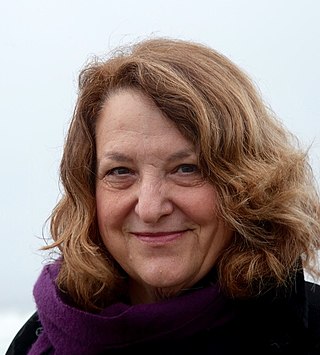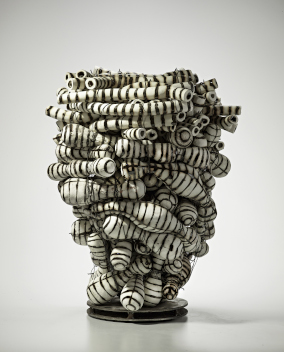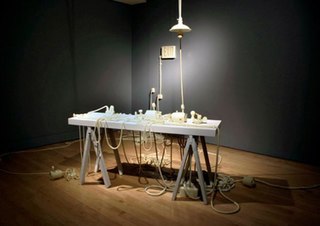
Amy Sillman is a New York-based visual artist, known for process-based paintings that move between abstraction and figuration, and engage nontraditional media including animation, zines and installation. Her work draws upon art historical tropes, particularly postwar American gestural painting, as both influences and foils; she engages feminist critiques of the discourses of mastery, genius and power in order to introduce qualities such as humor, awkwardness, self-deprecation, affect and doubt into her practice. Profiles in The New York Times, ARTnews, Frieze, and Interview, characterize Sillman as championing "the relevance of painting" and "a reinvigorated mode of abstraction reclaiming the potency of active brushwork and visible gestures." Critic Phyllis Tuchman described Sillman as "an inventive abstractionist" whose "messy, multivalent, lively" art "reframes long-held notions regarding the look and emotional character of abstraction."

Lynn Hershman Leeson is an American multimedia artist and filmmaker. Her work with technology and in media-based practices is credited with helping to legitimize digital art forms. Her interests include feminism, race, surveillance, and artificial intelligence and identity theft through algorithms and data tracking.
Peter Forakis was an American artist and professor. He was known as an abstract geometric sculptor.

Alyson Shotz is an American sculptor based in Brooklyn, New York. She is known for experiential, large-scale abstract sculptures and installations inspired by nature and scientific concepts, which manipulate light, shadow, space and gravity in order to investigate and complicate perception. Writers suggest her work challenges tenets of monumental, minimalist sculpture—traditionally welded, solid, heavy and static—through its accumulation of common materials in constructions that are often flexible, translucent, reflective, seemingly weightless, and responsive to changing conditions and basic forces. Sculpture critic Lilly Wei wrote, "In Shotz’s realizations, the definition of sculpture becomes increasingly expansive—each project, often in series, testing another proposition, another possibility, another permutation, while ignoring conventional boundaries."

Annabeth Rosen is an American sculptor best known for abstract ceramic works, as well as drawings. She is considered part of a second generation of Bay Area ceramic artists after the California Clay Movement, who have challenged ceramic traditions involving expression, form and function and helped spur the medium's acceptance in mainstream contemporary sculpture. Rosen's sculptures range from monumental to tabletop-sized, and emerge out of an accumulative bricolage process combining dozens or hundreds of fabricated parts and clay fragments and discards. Reviewers characterize her art as deliberately raw, both muscular and unapologetic feminine, and highly abstract yet widely referential in its suggestions of humanoid, botanical, aquatic, artificial, even science-fictional qualities. Critic Kay Whitney wrote that her work is "visceral in its impact, violent even, but also sensual and evocative" and "floats between the poles of the comic and the mordant."

Jeanne Silverthorne is an American sculptor, known for cast-rubber sculptures and installations that explore the artist's studio as a metaphor for artistic practice, the human body and psyche, and mortality. She gained prominence in New York City in the 1990s, as one of several material-focused sculptors who critiqued the austere, male-dominated Minimalist movement by embracing humble, unorthodox media and hand-made, personal and ephemeral qualities championed by artists such as Eva Hesse and Louise Bourgeois. She treats the studio as a physical and conceptual site to be excavated, documented and inventoried, examining in the words of Sculpture's Jan Riley "the end of studio arts … and the impossibility of this mode of expression regaining its former creative validity and vitality in today’s world." Art in America critic Raphael Rubinstein wrote that, like the late studio paintings of Philip Guston, Silverthorne examines "deeply melancholic realms, enlivened by the occasional mordant joke, in which lowly objects are relentlessly and lovingly queried for a meaning they never seem quite ready to yield."
Dike Blair is a New York-based artist, writer and teacher. His art consists of two parallel bodies of work: intimate, photorealistic paintings and installation-like sculptures assembled from common objects—often exhibited together—which examine overlooked and unexceptional phenomena of daily existence in both a romantic and ironic manner. Blair emerged out of the late 1970s New York art scene, and his work relates to concurrent movements such as the Pictures Generation, Minimalism and conceptual art, while remaining distinct from and tangential to them. New York Times critic Roberta Smith places his sculpture in a "blurred category" crossing "Carl Andre with ikebana, formalist abstraction with sleek anonymous hotel rooms, talk-show sets with home furnishings showrooms." Cameron Martin writes in Artforum that the paintings are "rendered with a lucidity that extracts something metaphysical from the mundane."

Charles Ross is an American contemporary artist known for work centered on natural light, time and planetary motion. His practice spans several art modalities and includes large-scale prism and solar spectrum installations, "solar burns" created by focusing sunlight through lenses, paintings made with dynamite and powdered pigment, and Star Axis, an earthwork built to observe the stars. Ross emerged in the mid-1960s at the advent of minimalism, and is considered a forerunner of "prism art"—a sub-tradition within that movement—as well as one of the major figures of land art. His work employs geometry, seriality, refined forms and surfaces, and scientific concepts in order to reveal optical, astronomical and perceptual phenomena. Artforum critic Dan Beachy-Quick wrote that "math as a manifestation of fundamental cosmic laws—elegance, order, beauty—is a principle undergirding Ross’s work … [he] becomes a maker-medium of a kind, constructing various methods for sun and star to create the art itself."
Jiha Moon is a contemporary artist who focuses on painting, printmaking, and sculptural ceramic objects. Born in Daegu, South Korea, Moon is currently based in Tallahassee, Florida, after years of living and working in Atlanta, Georgia. She joined Florida State University's Art department faculty in the fall of 2023.

Harry Dodge is an American sculptor, performer, video artist, professor, and writer.
Charles Gaines is an American visual artist, whose work interrogates the discourse of aesthetics, politics, and philosophy. Taking the form of drawings, photographic series and video installations, the work consistently involves the use of systems, predominantly in the form of the grid, often in combination with photography. His work is rooted in conceptual art – in dialogue with artists such as Sol LeWitt, Lawrence Weiner and Mel Bochner – and Gaines is committed to its tenets of engaging cognition and language. As one of the only African-American conceptual artists working in the 1970s, a time when political expressionism was a prevailing concern among African-American artists, Gaines was an outlier in his pursuit of abstraction and non-didactic approach to race and politics. There is a strong musical thread running through much of Gaines' work, evident in his repeated use of musical scores as well in his engagement with the idea of indeterminacy, as similar to John Cage and Sol LeWitt. He lives in Los Angeles, California.

Elizabeth King is an American sculptor and writer known for movable figurative sculptures that she has employed in stop-frame animations. Her work combines exacting handcraft, elementary mechanics, and digital and electronic technologies, applied in sculptures of half or full figures, heads, arms and hands, or even simply eyes. She often equips figures with subtly illuminated eyes and visible and invisible mechanisms enabling the performance of anatomically correct simple operations, seemingly of their own volition. Writers have described her figures as "insistently nonhuman" yet "uncannily alive" in their ability to project self-awareness, intelligence, agency and emotion. They reflect her interests in early clockwork automata, the history of the mannequin and puppet, literature involving unnatural figures come to life, and human movement. Art in America critic Leah Ollman wrote that King's "highly articulated automatons invite us to consider how consciousness arises from physical being … she portrays her mechanical surrogates as convincingly self-aware, while we are left to ponder that age-old question: where exactly does the self reside?"
Miranda Lichtenstein is an American artist focusing on photography and video.
Amy Ellingson is an American contemporary abstract painter. She is a native of the San Francisco Bay Area and currently lives and works in Santa Fe, New Mexico.

Kambui Olujimi is a New York-based visual artist working across disciplines using installation, photography, performance, tapestry, works on paper, video, large sculptures and painting. His artwork reflects on public discourse, mythology, historical narrative, social practices, exchange, mediated cultures, resilience and autonomy.
Rebeca Bollinger is an American artist. She works with sculpture, photography, video, drawing, installation, writing and sound.

Helen O'Leary is an Irish-born artist based in the United States and Ireland, known for constructions that blur the boundaries between painting and sculpture and object and image. She uses bricolage and handicraft approaches to refashion older works, studio castoffs and diverse materials into abstract pieces that explore materials, language, remnants of the past, and the visual, cultural and emotional influences of origin. She has exhibited internationally, including shows at the Irish Museum of Modern Art (IMMA), Metropolitan Arts Centre (MAC) (Belfast), American Academy of Arts and Letters, SFMOMA, the Sanskriti Foundation, Victorian College of the Arts (Melbourne), and Centre Culturel Irlandais (Paris). Her work has been recognized by the American Academy in Rome and John S. Guggenheim, Pollock-Krasner and Joan Mitchell foundations, numerous residencies, and reviews in The Times (UK), The New York Times, Chicago Tribune, The Irish Times, and Arts Magazine, among others.

Harriet Korman is an American abstract painter based in New York City, who first gained attention in the early 1970s. She is known for work that embraces improvisation and experimentation within a framework of self-imposed limitations that include simplicity of means, purity of color, and a strict rejection of allusion, illusion, naturalistic light and space, or other translations of reality. Writer John Yau describes Korman as "a pure abstract artist, one who doesn’t rely on a visual hook, cultural association, or anything that smacks of essentialization or the spiritual," a position he suggests few post-Warhol painters have taken. While Korman's work may suggest early twentieth-century abstraction, critics such as Roberta Smith locate its roots among a cohort of early-1970s women artists who sought to reinvent painting using strategies from Process Art, then most associated with sculpture, installation art and performance. Since the 1990s, critics and curators have championed this early work as unjustifiably neglected by a male-dominated 1970s art market and deserving of rediscovery.

Michael Arcega is a San Francisco-based interdisciplinary artist who works mainly in sculpture and installation. Critics have described his work as a fusion of accessible materials, meticulous craftsmanship, politically barbed punning and conceptual rigor that balances light-hearted play with serious critique. His practice is informed by history, research, geography and his personal, insider-outsider sensibility as a naturalized Filipino-American; he frequently links historical eras and disparate geographies in order to address the present via the past. While visual, his art is often inspired by bilingual wordplay, jokes and jumbled signifiers. It explores cross-cultural exchange, colonization, sociopolitical dynamics and imbalances, and cultural markers embedded in objects, food, architecture, visual lexicons, and vernacular languages. Sculpture critic Laura Richard Janku wrote that Arcega "melds myriad aspects of past and present, high and low, humor and horror into the messy melting pot of history, politics and culture."

Tuan Andrew Nguyen is a Vietnamese-American artist known for moving-image works, sculptures and installations. His work taps into counter-memory, testimony and dialogue as forms of political resistance and empowerment, highlighting unofficial and underrepresented histories involving the fragmented consciousness of colonial inheritance and the cultural estrangement of expatriation and repatriation. He interweaves factual and speculative elements—archival resources, fiction, explorations of material memory embedded in objects (animism), and supernatural realms—in order to rework dominant narratives into poetic vignettes that imagine alternate forms of healing, survival and political potentiality. In 2023, New York Times critic Roberta Smith wrote, "Nguyen is a documentarian and an assembler of broken things with a preference for collaboration. His work aims to heal the fragmented lives and retrieve the suppressed memories of the marginalized people most affected by colonization, war and displacement, especially in Vietnam."













